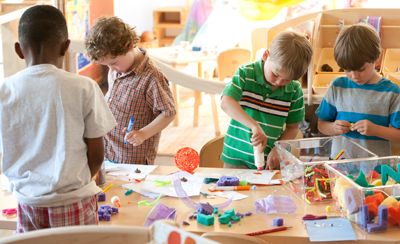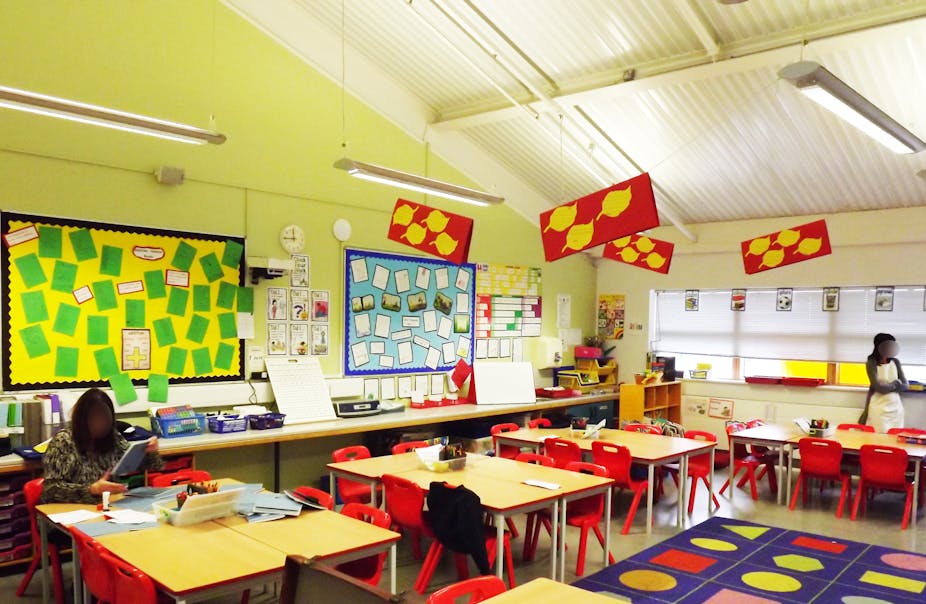The children in the Montessori method learn through exploration and creativity. Montessori education helps them get a better understanding of their individuality and increases their confidence.
In order to understand this statement better, discuss the following questions:
- What is Child Centered Education?
- How is a classroom made child centered?
- What is a teacher-led classroom?
- What is a student-led classroom?
A child centered education is where the activities and lessons are prepared keeping in mind the needs and interests of the child. A classroom can be made child centered when it is prepared keeping in mind what the child wants and needs to learn.
- In Montessori, the classroom and all the activities are prepared keeping this in mind. For example, if a child really enjoys the sandpaper letters activities, then the guide can include this in more presentations. If a child enjoys making shapes with playdough, then the guide can include this in more sessions.

- As we discussed earlier, the traditional education focuses on passive listening and rote learning which makes the lessons extremely mundane for the students. Traditional school lessons are often taught to children who listen passively, memorize, and take tests. This also causes less retention and loss of interest and attention in students. So, how can this problem be solved?
The lessons should be based on hands-on learning and active participation of children so that the children discover information for themselves rather than just memorizing it.
This is exactly what the Montessori method does! Like, when teaching children how to read 3-letter words. Montessori guides use materials like sandpaper letters to help them sound out letters and blend the sounds to read words instead of just writing words on the board and reading them.

- Let’s take a look at the time table of a traditional school.

1. What do you think about this time table?
2. Is this the most efficient way to study? Why/ why not.
3. What do you think can be the issue with this time table?
In a traditional school, the entire day is preplanned. If a student wants to continue learning English through the second period, that can’t be done. Once a period is over, a bell is rung and the students need to close that subject and go on to the subject of the next period. This can be really hectic as well.
What can be a better alternative to this?
Let’s assume a child wanted to continue working on movable alphabets. Then, instead of hindering his flow, the guide would let him work on that activity as long as he likes.
In the Montessori classroom, children work on lessons as long as need be, and interruptions are avoided whenever possible. Time barriers are not there because it is believed that there is a reason why a child is driven to work on something. There are no bells to dictate the students’ experiences.

- Age Groups and Grade Levels: In Montessori schools, “grade-levels” are flexible and determined by the child’s developmental range, i.e., 0-3, 3-6, 6-9, 9-12, 12-15, and 15-18 years of age. In traditional schools, grade levels are not flexible and strictly defined by chronological age within a twelve-month period.
- Self Esteem From Within: Montessorians understand that the child’s self-esteem comes from an internal sense of pride in his or her own accomplishments. In traditional classrooms, self-esteem is thought to come from external judgement and validation.
- Montessorians also focus on intrinsic motivation in children. What does intrinsic motivation mean?
The goal behind in the Montessori method is to make children enjoy the process of learning and make them want to learn new things. The focus is on motivation from within the child to learn. This is called intrinsic motivation.
- Organized Décor Calms the Montessori Classroom:
Imagine a traditional classroom. What does it look like?
There are a lot of desks on which students are sitting. There is a chair and a table for the teacher. A blackboard is in front of the desks and a chalk box on the wall. The walls are bright colored with a lot of posters, drawings and pictures.

- Describe the learning experience in such a classroom.
The teacher is teaching the children a nursery rhyme. First, the teacher will recite and then the children will recite after the teacher. The children recite, “Ba, Ba, Black sheep, have you any wool?”
Then suddenly a child notices that there is a picture of a sheep on the wall. The sheep is white and black. And it seems like it is smiling at the picture of the minnie mouse. The minnie mouse has a pink bow and a dress. She is standing next to the picture of Daisy Duck who has a purple ribbon. Then the child thinks, “I also want a purple bow.”
By the time this chain of thoughts ends, the rhyme has finished and the child missed it.
Now, let’s see what a ,Montessori classroom looks -

In the Montessori classroom, the room is divided into five subject areas - Practical Life, Mathematics, Sensorial Development and Culture & Sciences. The classroom is organized and uncluttered with only those materials that are required for certain activities. Montessori classrooms also have child-size furniture and emphasize that this is a learning space. While traditional classrooms use bright colors, posters and drawings to excite the children, Montessori classrooms aim to provide a calm environment to stimulate children's minds and provide quality lessons.
- Benefit to Children with ADHD:
Do you think a traditional classroom is equipped to teach children with ADHD or autism?
Why/ why not?
The traditional classrooms and curriculums are built for students to sit in a place, listen
to what the teacher is saying and understand or memorize that concept. This can work
for neuro-typical children to some extent. But neuro-divergent students are driven by interest and are easily distracted. The mechanical methods of the traditional classroom and curriculum aren’t sufficient to fulfil the needs of such children.
ADHD and Autistic children work better in an organised, structured environment where there are minimal distractions and empathy as well as social skills are a part of the curriculum itself which is why Montessori method of education is highly beneficial for such children.


